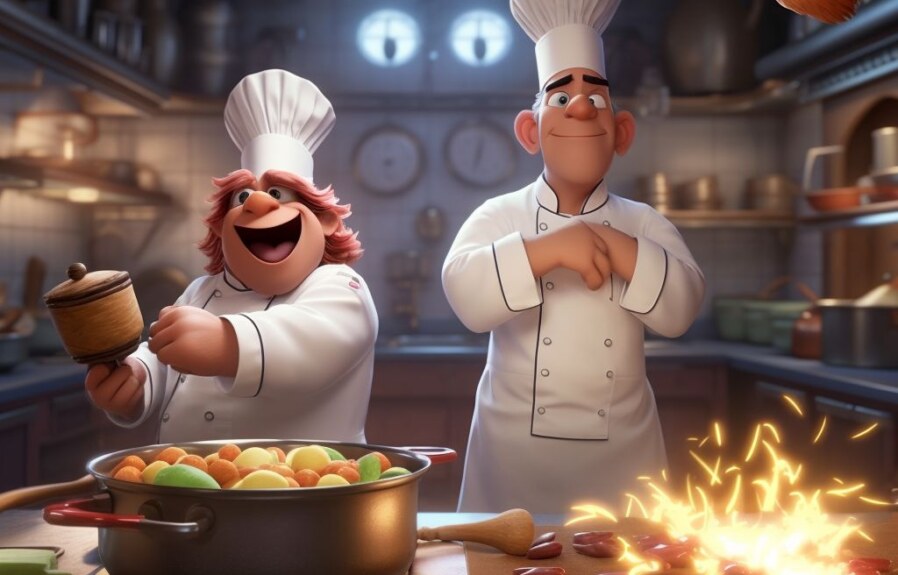A perfectly cooked chicken is a treat to the taste buds, but it can be a challenge to ensure that it is cooked thoroughly without overcooking it. Undercooked chicken poses a significant health risk as it carries harmful bacteria that can lead to food poisoning. Along with the possibility of getting sick, eating undercooked chicken just doesn’t taste good. In this article, we will guide you through the process of identifying if your chicken is undercooked and how to prevent it from happening in the first place. By following these essential tips, you will be able to cook a chicken with confidence and peace of mind, knowing that it is safe and delicious.
1. Understanding Why Chicken Needs to be Cooked Thoroughly
Chicken is a popular source of protein that is used in a wide variety of dishes. It’s also easy to prepare and cook, making it a staple in many kitchens. However, it’s essential to remember that undercooked chicken can lead to the spread of harmful bacteria, such as salmonella and campylobacter.
When chicken is undercooked, the bacteria present in it is not destroyed, making it unsafe to consume. This is why it is crucial to always cook chicken thoroughly to kill any harmful bacteria that may be present.
It’s important to note that while cooking chicken thoroughly is essential, it’s also essential to avoid overcooking. Overcooked chicken may become dry and tough, making it less enjoyable to eat. The key is to cook the chicken until it reaches the right internal temperature, which we will discuss in more detail later.
To ensure that you are handling chicken safely, always remember to wash your hands thoroughly before and after handling raw chicken, sanitize any surfaces that have come into contact with raw chicken, and use separate cutting boards and utensils for raw chicken and cooked food. By following these guidelines, you can ensure that your chicken is cooked thoroughly and safely enjoyed by all those who eat it.
2. Simple Tricks to Check If Chicken is Undercooked
When cooking chicken, it’s essential to cook it thoroughly to avoid the risk of food poisoning. Undercooked chicken can contain harmful bacteria such as salmonella, which can make you sick. It’s important to check the chicken properly to ensure that it’s cooked through. This section will provide you with simple tricks to help you tell if chicken is undercooked.
The Skin
One of the easiest ways to check if chicken is undercooked is to look at the skin. When chicken is cooked, the skin should be golden brown and crispy. If the skin is still pink, and the surface does not have that crispy texture, then it is likely that the chicken is undercooked.
The Juices
Another way to check if chicken is undercooked is to examine the juices that come out of it. When chicken is cooked, the juices from the meat should run clear, rather than being pink or red. If the juices are still pink or red, this means that the chicken is undercooked and needs more time to cook.
The Texture
The texture of cooked chicken is also an essential indicator. When chicken is cooked thoroughly, the meat should be firm and not have any pink or raw patches. If the chicken feels soft or has a rubbery texture, it’s likely that it is undercooked, and you need to cook it for longer.
By following these tricks, you can make sure that your chicken is cooked thoroughly and safe to eat. Remember, it’s crucial to avoid undercooked chicken to protect yourself and your loved ones from foodborne illnesses.
3. Importance of Internal Temperature when Checking for Undercooked Chicken
When cooking chicken, we cannot rely on just the appearance of the meat to determine whether it is cooked or not. We need to ensure that the internal temperature of the chicken has reached a safe level to kill any harmful bacteria that may be present. The risk of foodborne illness from consuming undercooked chicken is high and can have serious consequences, so taking the internal temperature of your chicken is a must.
Food Safety Guidelines
According to the U.S. Food and Drug Administration (FDA), the internal temperature of chicken must reach 165°F (74°C) before it can be considered safe to eat. At this temperature, any harmful bacteria that may be present in the chicken would have been killed. Using a meat thermometer is the best way to determine the internal temperature of your chicken.
How to Use a Meat Thermometer
To use a meat thermometer, insert it into the thickest part of the chicken, making sure that the tip of the thermometer is not touching bone or fat. Wait for a few seconds until the temperature reading stabilizes, then remove the thermometer. If the temperature reads 165°F (74°C) or above, your chicken is safe to eat. If it reads lower than this, your chicken is undercooked and needs to be cooked further until it reaches the safe internal temperature.
Checking the internal temperature of your chicken is a simple yet crucial step in ensuring that your meal is safe to consume. Always have a meat thermometer handy in your kitchen and ensure that it is calibrated properly to get accurate readings. Remember that the visual appearance of chicken is not a reliable indicator of whether it is cooked thoroughly or not – always check the internal temperature.
4. What Happens if You Consume Undercooked Chicken?
Consuming undercooked chicken can have severe health consequences. When chicken is undercooked, it may still contain harmful bacteria such as salmonella or campylobacter, which can cause food poisoning. These bacteria can survive even after cooking, especially if the internal temperature of the chicken is not met.
Symptoms of food poisoning can range from mild to severe, including nausea, vomiting, diarrhea, abdominal cramps, and fever. In some cases, food poisoning may require medical attention, especially if it leads to dehydration or other complications.
Moreover, if you consume undercooked chicken regularly, it can increase your risk of developing other health problems such as irritable bowel syndrome, inflammatory bowel disease, or even cancer. Therefore, it’s important to ensure that the chicken is cooked to the recommended temperature and to follow proper food handling and storage protocols.
To avoid the risks of consuming undercooked chicken, always use a proper meat thermometer to check the internal temperature of the chicken. As a rule of thumb, the FDA recommends cooking chicken to an internal temperature of 165°F for at least 15 seconds. Additionally, it’s recommended to wash your hands and any kitchen utensils or surfaces that have come in contact with raw chicken to prevent cross-contamination.
In case you consume undercooked chicken accidentally, it’s important to seek medical attention immediately, especially if you experience severe symptoms. Don’t delay consulting your doctor even if the symptoms appear mild, as food poisoning can lead to serious complications if left untreated.
5. Common Mistakes to Avoid While Cooking Chicken
:
Cooking chicken to perfection requires precision and attention to detail, but there are common mistakes that many people make which can result in undercooked or overcooked chicken. In order to avoid any unpleasant experiences, it’s important to be aware of these mistakes and how to avoid them.
Not Thawing Chicken Properly:
Many people often make the mistake of not thawing chicken properly before cooking, leading to uneven cooking and the risk of undercooking. It’s important to thaw chicken in the refrigerator, which can take up to 24 hours, depending on the size of the chicken. Avoid thawing chicken at room temperature, which can increase the risk of bacterial growth, leading to foodborne illnesses.
Cooking Chicken at the Wrong Temperature:
Cooking chicken at the wrong temperature can also result in undercooked or overcooked meat. Chicken needs to be cooked to a minimum internal temperature of 165°F (73.9°C) in order to be considered safe to eat. Use a meat thermometer to accurately determine the internal temperature of the chicken while cooking.
Not Letting Chicken Rest:
Many people make the mistake of not letting chicken rest after cooking, resulting in dry, tough meat. It’s important to let the chicken rest for at least 5-10 minutes after cooking to allow the juices to redistribute throughout the meat, resulting in moist and tender chicken.
By avoiding these common mistakes and following best practices for cooking chicken, you can ensure that your chicken is cooked to perfection every time. Use a meat thermometer to accurately determine the internal temperature of the chicken, take the time to thaw properly, and allow the chicken to rest after cooking for the best results.
6. How to Fix Undercooked Chicken Safely
If you have realized that your chicken is undercooked, don’t panic. There are a few ways you can salvage it without compromising your health. The first is by returning the chicken to the pan or griddle and cooking it further until it reaches the desired temperature. You can check the temperature by inserting a meat thermometer into the thickest part of the chicken. The temperature should be at least 165°F (74°C) to ensure it is safe to eat.
Another way to fix undercooked chicken is by placing it back on the grill or broiler. The heat will cook the chicken from all sides and eliminate any bacteria that may cause food poisoning. Make sure to keep turning and flipping the chicken as it cooks to ensure it cooks evenly.
Avoid using a microwave to cook undercooked chicken as it may leave some parts uncooked or unevenly cooked. Moreover, the texture and taste of chicken cooked in a microwave are usually unappetizing.
If you are in a hurry and cannot re-cook the undercooked chicken, you can chop it into pieces and boil it in water for about 10-15 minutes. Boiling the chicken will ensure that it is cooked all the way through and is safe to eat. However, boiled chicken may not taste as good as grilled or pan-fried chicken, so make sure to season it well before serving.
Conclusion:
Fixing undercooked chicken is not hard, but it requires you to be patient and cautious. The best way to prevent undercooked chicken is by using a meat thermometer to check the internal temperature and ensuring you cook the chicken thoroughly. Remember to always handle raw chicken safely to prevent foodborne illnesses.
7. Final Tips to Prevent Undercooked Chicken in Your Meals
To avoid the perils of undercooked chicken, it’s important to follow some precautions while handling and cooking it. Here are some tips to help prevent undercooked chicken in your meals:
Cleanliness is Key:
Make sure your hands, knives, utensils, and cutting board are thoroughly clean and dry before handling raw chicken. Wash your hands and utensils after each stage in the cooking process, particularly when handling raw chicken, to prevent contamination from any harmful bacteria present in the raw meat.
Avoid Cross-contamination:
It’s critical to keep raw chicken from contaminating other foods in your kitchen. When storing raw chicken, keep it at the bottom of the refrigerator in a separate container, so its juices don’t drip onto other foods. When preparing chicken, use separate cutting boards and knives and avoid touching other surfaces and ingredients before washing your hands.
Thorough Cooking is Crucial:
Chicken needs to reach a minimum internal temperature of 165°F to ensure that all the harmful bacteria are destroyed. Use a meat thermometer to check the doneness of the chicken, and make sure the temperature probe is inserted into the thickest part of the chicken. Pay attention to the color and texture of the meat, as they are good indicators of doneness.
By following these final tips for preventing undercooked chicken in your meals, you can enjoy delicious and safe chicken dishes without any worries about food poisoning. So make sure to be clean, avoid cross-contamination, and cook your chicken thoroughly for a healthy and happy dining experience!
People Also Ask
What are the signs that chicken is undercooked?
Signs that chicken is undercooked include pink or raw-looking meat, juices that are still pink or red, and a lack of clear or white juices. Additionally, the meat may feel soft or mushy.
How can you tell if chicken is cooked without a thermometer?
One way to tell if chicken is cooked without a thermometer is to pierce it with a fork or knife and check the juices that come out. If the juices are clear, the chicken is cooked. Another way is to cut into the meat and look for any pinkness or raw-looking parts.
Is it okay if chicken is a little pink?
It is not okay if chicken is a little pink, as this indicates that it is undercooked and may still contain harmful bacteria like salmonella. Chicken should be fully cooked until there is no pinkness and the juices run clear.
What should you do if you eat undercooked chicken?
If you eat undercooked chicken, you may be at risk for food poisoning. Symptoms can include nausea, vomiting, diarrhea, and fever. It is important to seek medical attention if you are experiencing any of these symptoms.
How long does it take to cook chicken thoroughly?
The amount of time it takes to cook chicken thoroughly will depend on the size and thickness of the chicken pieces. Generally, it should take 20-30 minutes to cook chicken breasts and 30-40 minutes to cook chicken thighs or drumsticks.
Conclusion
Undercooked chicken can be dangerous to consume, as it may contain harmful bacteria that can lead to food poisoning. Signs that chicken is undercooked include pink or raw-looking meat, juices that are still pink or red, and a lack of clear or white juices. Always ensure that chicken is cooked fully until there is no pinkness and the juices run clear to reduce the risk of foodborne illness.



